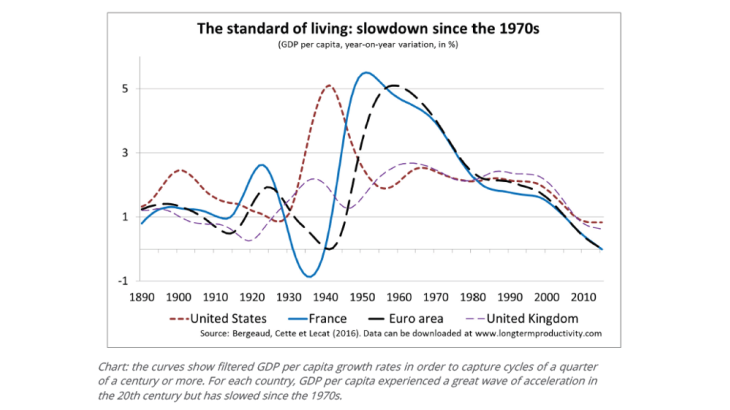GDP per capita: a good indicator of the economic standard of living
In the most common cases, economic standard of living is measured using GDP per capita. The latter has slowed continuously over the past decades in developed countries. For instance, the annual GDP per capita growth rate was 0.6% in the United States over the 2005-2015 period compared with 2.2% in the 20th century, and 0.3% in France compared with 2.1% for the same periods (see the above Chart taken from "Rue de la Banque", No. 11).
A great wave of growth during the 20th century
In each country or economic area, we observe a long and pronounced wave of GDP per capita growth during the 20th century. Every region was not affected in the same way: from the 1930s to the 1950s, it concerned the United States, then later, after the Second World War until the 1960s, the euro area (recompiled using values for Germany, France, Italy, Spain, the Netherlands, Belgium, Portugal and Finland), and namely France, and to a lesser extent the United Kingdom. The size of the wave also varies significantly depending on the economies: countries with the highest starting level of GDP per capita, namely the United Kingdom, experienced the slowest growth.
This wave corresponds mainly to the spread of innovations developed during the Second Industrial Revolution, which spurred productivity growth and consequently the average economic standard of living. These innovations covered an extremely wide range of activities, including chemicals, pharmaceuticals, energy (oil and electricity), transportation and industrial power generation (the electric motor and combustion engine) as well as telecommunications (telephones, radio and cinema). This wave was also linked to innovations in manufacturing processes (Taylorism) and financing methods (Bergeaud, Cette and Lecat, 2016). Thanks to trade liberalisation, advances in education and better adapted economic institutions, the other advanced countries benefited from a post-war catch-up process.
A slowdown in successive stages since the 1970s
In the advanced countries considered here, GDP per capita has slowed in successive stages since the 1970s, with a brief interruption caused by the information and communication technology (ICT) revolution. The size of this new cycle was more limited, with GDP per capita peaking in the United States at just over 2% at the turn of the 2000s (with GDP increasing more due to demographic effects). It was also shorter, slowing down in the mid-2000s prior to the financial crisis. Although, not all countries reaped the benefits of the ICT revolution and clearly, GDP per capita in Europe did not accelerate.
The consequences of this new order were significant for the countries and populations concerned. For example, the sustainability of social expenditure such as pensions, as well as public spending and more generally the ability to improve well-being were all made possible by the growth in GDP per capita. Could it be possible to benefit once again from the growth rates observed in the 20th century?
Catching up is impossible without ambitious reforms
The new slowdown in growth since the mid-2000s raises fears of a period of "secular stagnation", i.e. a long-term situation of negligible growth. Techno-pessimists (Robert Gordon in particular) argue that the "one big wave" of the 20th century was an isolated incident in the history of humanity caused by an exceptional series of simultaneous innovations in a number of fields. The slowdown in productivity, that can be shown to have started prior to the financial crisis, was largely due to the lower contribution of ICT, which supports this hypothesis.


